How to Fix ‘Windows was unable to load the registry’ Error
Several users have been reaching us with questions after they discovered a persistent error inside the Event Viewer that reads “Windows was unable to load the registry. This problem is often caused by insufficient memory or insufficient security rights”. Most affected users didn’t report any associated symptoms with this issue (other than this recurring error message). The issue isn’t exclusive to a certain Windows version as it’s also encountered on Windows 10, Windows 8.1 and Windows 7.
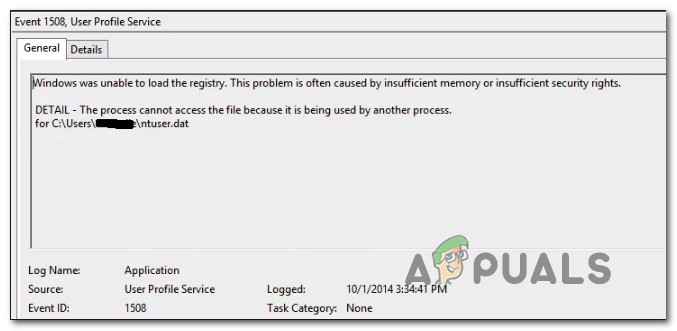
What is causing the “Windows was unable to load the registry”?
We investigated this particular issue by looking into various user reports and the repair strategies that are most commonly being used to fix this particular behavior. As it turns out, there are several different culprits that might be responsible for this error message. We went ahead and created a list with the most likely elements that might end up causing this issue:
- Power interrupted during the logon/logoff procedure – This scenario is fairly common, especially on Windows 7 and Windows 8.1. An interrupted logon/logoff procedure can end up creating profile corruption which might trigger this Error event. In this case, you should be able to resolve the issue by following a procedure that fixes file system file corruption.
- Bad application installed or uninstalled – As it turns out, this issue can also occur due to a bad application install or uninstall. This can end up to some degree of registry corruption which might cause certain issues with the way Windows makes use of the registry values.
- Network dropout or virus /spyware – As per several user reports, this issue can also be caused by a pesky malware that corrupted certain system files. If this scenario is applicable, you should be able to fix the issue by removing the malware from your system and repairing any affected system files.
- Corrupted UsrClass.dat profile – If you’re encountering search malfunctioning symptoms on top of the Event Viewer errors, chances are you’re dealing with a corrupted UsrClass.dat profile. In this case, you should be able to resolve the issue by deleting the file, forcing Windows to create a new, healthy copy.
- Corrupted Windows profile – As it turns out, this particular issue can also occur in situations where you’re actually dealing with a corrupted Windows profile. If this corruption cannot be fixed with the built-in utilities (SFC and DISM), you should be able to fix work around the issue by creating a new Windows account.
If you’re currently looking for ways to resolve this error message, this article will provide you with several different troubleshooting steps. Down below, you’ll be able to find a collection of methods that other users in a similar situation have successfully used to resolve the “Windows was unable to load the registry” error.
In order to remain as efficient as possible, we advise you to follow the potential fixes below in the order that they are presented since we ordered them by efficiency and severity. Eventually, you should stumble upon a fix that will resolve the issue regardless of the culprit that’s causing it.
Method 1: Removing malware infections (if applicable)
If you suspect that the “Windows was unable to load the registry” error might be caused by some type of malware, adware or spyware that ended up corrupting some system files, it’s important to ensure that the virus infection is completely removed before you try to repair the corrupted files.
The quickest and most effective way to do this (in our experience) is to deploy a Deep Malwarebytes scan and let it inspect your whole system and all of your peripherals (not just the Windows drive).
If you’re not exactly sure on how to do this, refer to this article (here) for step-by-step instructions on running a Deep Malwarebytes scan.
Once you complete this process and you ensure that all virus traces have been removed, move down to the next method below.
Method 2: Repairing System File Corruption
Since most culprits that might end up causing the “Windows was unable to load the registry” error inevitably lead up to System File corruption, you need to take the steps necessary to resolve any type of corruption that might affect your operating system.
In this case, the easiest and most effective ways to repair any degree of System File corruption is with utilities like System File Checker (SFC) and Deployment Image Servicing and Management (DISM).
Both of these built-in tools have virtually the same capabilities, but they do things in various different ways. The first one (SFC), uses a locally stored cache to replace corrupted system files with fresh copies while DISM relies on Windows Update to download fresh copies in order to replace corrupted items that it manages to detect.
Since DISM was designed as sort of a backup plan in case SFC fails to remove the corruption, we advise you to run both utilities in order in order to fix the corruption and resolve the “Windows was unable to load the registry” error.
Here’s a quick guide on running SFC and DISM scans from an elevated Command Prompt:
- Press Windows key + R to open up a Run dialog box. Then, type “cmd” and press Enter to open up an elevated Command Prompt. When asked by the UAC (User Account Prompt), click Yes to grant administrative privileges.

Running Command Prompt as an administrator - Once you manage to get inside the elevated Command Prompt, type the following command and press Enter to initiate an SFC scan:
sfc /scannow
Note: Keep in mind that after you start this procedure, closing the CMD window or your computer might facilitate further system file corruption. With this in mind, don’t try to close the utility or restart your computer until the procedure is complete.
- Once the process is complete, restart your computer and wait until the next startup is complete.
- When your computer is fully booted up, follow step one again to open up another elevated CMD window. Then, type the following command and press Enter to initiate a DISM scan:
DISM /Online /Cleanup-Image /RestoreHealth
Note: Keep in mind that since DISM relies on Windows Update to download fresh copies in order to replace corrupted files, it needs a stable internet connection in order to function properly.
- Once the DISM scan is finished, restart your computer once again and see if the issue is still occurring once the next startup sequence is complete.
If you’re still seeing new events with the “Windows was unable to load the registry”, move down to the next method below.
Method 3: Deleting the UsrClass.dat file
Some users that have been encountering this issue on Windows 10 with symptoms like malfunctioning search function or Start menu not expanding have to manage to resolve the issue by deleting the UsrClass.dat file from the AppData folder.
Under certain circumstances, this procedure deletes some corrupted registry key, which forces Windows 10 to create a new healthy copy that will not have the same issue.
Here’s a quick guide on deleting the UsrClass.dat file:
- Open file explorer on your computer, click on the View tab from the ribbon bar at the top of the screen and check the box associated with Hidden Items.

Click View Then Check Unhide Hidden Items To Make Sure All The Folders Are Shown - Once you make all hidden folders visible, navigate to the following location:
C:\Users\*YourUser*\AppData\Local\Microsoft\Windows
Note: Keep in mind that *YourUser* is simply a placeholder for the user account that you’re using. Replace it accordingly.
- When you get to this location, scroll down through the list of items and locate UsrClass.dat. Once you see it, right-click on it and choose Delete from the context menu.
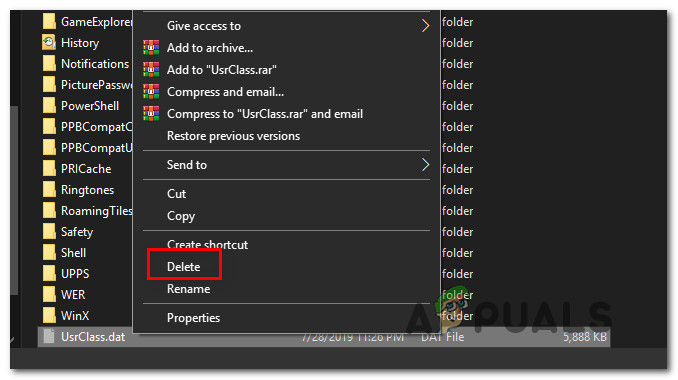
Deleting the USR class - Once the file has been deleted, restart your computer and see if the issue has been resolved once the next system startup is complete.
If you’re still seeing new Event Viewer errors with the “Windows was unable to load the registry” message, move down to the next method below.
Method 4: Creating a new user profile
Since in most cases, the issue is caused by a corrupted user profile, in most cases you’ll be able to resolve the issue by creating a new profile for your Windows computer. Upon completing this procedure, any corrupted dependencies associated with the current user profile will be replaced with healthy copies.
Several affected users have reported that they managed to resolve the issue by creating a new user profile. The “Windows was unable to load the registry” error no longer occurred once they made the switch to the new account.
Here’s a quick guide on creating a new user account on Windows 10:
- Press Window key + R to open up a Run dialog box. Then, type “ms-settings:otherusers” inside the text box and press Enter to open up the Family & other people tab of the Settings app.
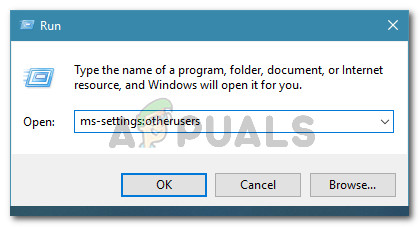
Running dialog: ms-settings:otherusers - Once you’re inside the Family & other users tab, scroll down to the Other users tab and click on Add someone else to this PC.
- From the next screen, add the email or phone associated with the Microsoft account or click on ‘I don’t have this person’s sign-in information’ if you’re planning on creating a local account.
- From the next screen, login with your Microsoft account or click on Add a user without a Microsoft account if you want to create a local account (some online feature will not be available).
- Add a User name and a password for the new account. You’ll then be prompted to assign security questions. Do it to secure your account and click Next.
- Once the account has been created, restart your computer and sign in with the newly created account at the next startup.
- When you’re logged in with your new account, access your Event Viewer and see if you’re still noticing errors that contain the “Windows was unable to load the registry” message.
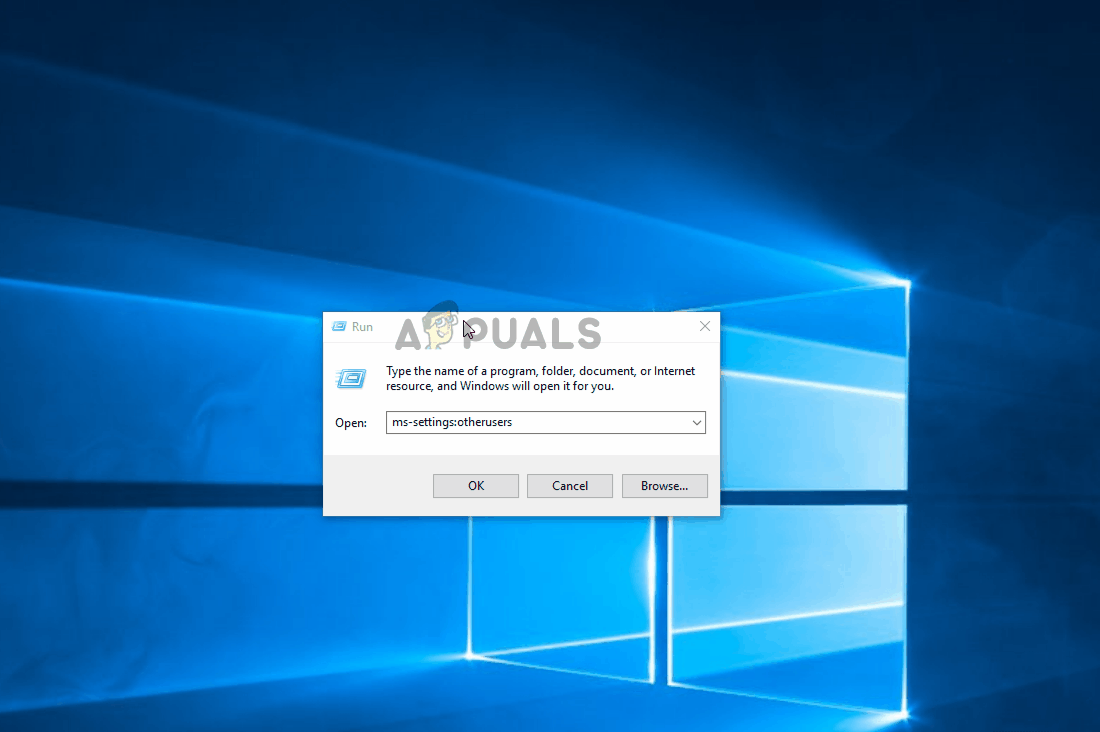
If you’re still experiencing the same symptoms, move down to the next methods below.
Method 5: Using a previous restore point
If you noticed that the issue only started to occur recently, you might be able to work around the issue by restoring your computer to a healthy point where the “Windows was unable to load the registry” error was not occurring.
All recent Windows versions will allow you to return your system to a healthy state by using restore points that were previously saved. If you’re lucky enough to have a restore point saved prior to when the issue started occurring, you should have no issues resolving the error.
But keep in mind that this procedure will also revert any other modifications that have been made since the restore point has been saved. If you want to go ahead with this potential fix, here’s a quick guide on doing a system restore:
- Press Windows key + R to open up a Run dialog box. Then, type ‘rstrui’ inside the text box and press Enter to open up System Restore wizard.

Opening the System Restore wizard via Run box - When you’re inside the System Restore wizard, click Next to advance to the next screen.
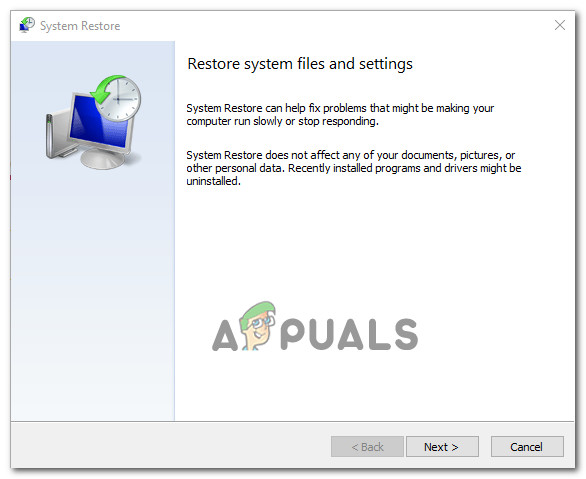
Getting past the initial screen of System Restore - Once you see the next screen, start by checking the box associated with Show more restore points. Next, look at the dates of each saved restore point and click on one that is dated before the apparition of the issue to select it. Then, click Next to advance to the next screen.

Restoring your system to a previous point in time IMPORTANT: Keep in mind that once you start this process, all installed applications, user preferences and anything else that was enforced after the restore point was created will be lost. This utility will restore your computer to the exact state at that time.
- Click Finish, and then confirm by clicking Yes at the confirmation prompt to start the process. Shortly after you do so, your computer will restart and the old state will be enforced.

Starting the System Restore process - Once your computer boots back up, see if the issue has been resolved by checking your Event Viewer.
If you still see new events with the “Windows was unable to load the registry” error, move down to the next method below.
Method 6: Performing a repair install
If none of the methods above have allowed you to resolve the issue, this procedure should allow you to resolve any scenario that is occurring due to system file corruption. The preferred approach would be to use a repair install to reset all Windows components including all related booting-related processes. The beauty of this method is that this procedure will not touch anything else other than Windows components.
As opposed from a clean install, you’ll be able to keep all your personal data including applications, personal media (photos, videos, music files).
If you decide to go for a repair install, follow the instruction on this guide (here) to learn how to do it (even if you don’t have an installation media.





